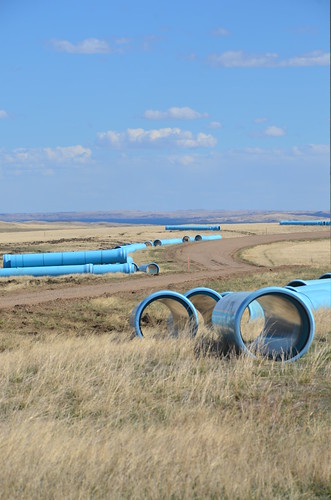
Over 20 years ago, Cheyenne River Sioux Tribal Council Member, Marcella Le Beau had a vision for her community. She was part of the initial planning process to bring abundant, safe drinking water to her tribe in north central South Dakota. It has been a multi-year undertaking beginning with a new water intake on the Missouri River. Today, the second phase is underway to increase the undersized water treatment plant. On Earth Day last week, I had the honor of gathering with Marcella, Senator Tim Johnson, and others on the ground where the new plant and trunk line from the Missouri River will be built.
“It is a momentous day for our Cheyenne River Sioux family,” Marcella told me, “We have worked a very long time, with many dedicated people involved, to make this happen.”

The Cheyenne River Reservation and adjacent counties are served by the Mni Waste’ Water Company located in Eagle Butte, South Dakota. The current capacity of the water plant is at its maximum of 1.2 million gallons of water per day, which is insufficient to serve the area. Challenges with the current water system have resulted in a moratorium on new home construction and have limited fire response time. Also, when water supplies run short, health care is impacted, and residents must travel over three hours for treatment.
These issues also create an enormous barrier to much-needed business development on the reservation which encompasses Dewey and Ziebach counties, two of the poorest in the nation. Sixty-two percent of the residents in Ziebach County live below the poverty level, and the median household income is $27,000--nearly half of the U.S. average. In addition, the Bureau of Indian Affairs estimates there to be a staggering 88-percent unemployment rate here.
Through the StrikeForce initiative, USDA is bringing together partners, increasing investments and creating opportunities to grow economies in poverty-stricken rural communities like the Cheyenne River Reservation. Over the past years, USDA has provided significant financing support to the Mni Waste’ Water Company through the Water and Environmental Program along with additional investments from the Indian Health Service and the Cheyenne River Sioux Tribe.
When the water treatment plant and transmission lines are completed, treatment and delivery capacity will be 4.4 million gallons per day and allow for future growth with a potential capacity of up to 8.8 million gallons daily. Over 14,000 residents will benefit from this much needed infrastructure.
Today, we can see the long-term community leadership and leveraged investments culminate in the final stages of this major undertaking. It is my pleasure to congratulate the board and staff at Mni Waste’ Water Company and the Cheyenne River Sioux Tribe for their hard work and persistence. This integral infrastructure expansion will provide the water necessary to bring new life and grow economic opportunities for generations to come.


